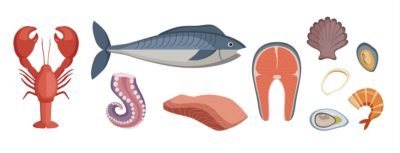Yes! The medical community recommends that parents offer their babies “allergenic” foods early on. “Allergenic” foods are foods commonly known to cause food allergies. Examples include peanut butter, eggs, fish, and shellfish.
Why Do Doctors Recommend the Early Introduction of Allergenic Foods?
Because research shows that babies who eat “allergenic” foods at a young age end up having fewer food allergies down the road.1
This is Actually the Opposite of What Doctors Used to Think.
Other “Popular” Practices That Have Fallen by the Wayside Over Time Include:
- Giving babies black coffee to start their day.
- Feeding babies soda.
- Allowing babies to sleep on their stomachs.
- Letting kiddos ride around in the front seat of a car without a car seat (or even a seatbelt!).
- Forcing left-handed kids to be righties.
- Putting babies in wire cages and hanging them out the window, so they can get fresh air.

Image Source: Rare Historical Photos.
And…The List Goes On.
Now that doctors have done a 180 on the introduction of allergenic foods, Get Wise about how (and when) to serve them, below.
The 411 on Introducing Allergenic Foods
Experts recommend that parents offer allergenic foods to their babies starting at 4-6 months of age (the American Academy of Pediatrics likes 6 months) after less allergenic foods have been tolerated. Make sure to get the green light from your baby’s doctor before offering your little one any allergenic foods, especially if he/she has a known food allergy, eczema, or a family history of food allergies.
PediaTip: The first time you introduce an allergenic food to your baby, try to do it on a weekend morning when people are home. Why? In case your child has an allergic reaction and you have to run to the hospital. Ask the doctor if you should have an antihistamine (such as Benadryl or Zyrtec) on hand too.
Heads Up: Antihistamines (particularly Benadryl) must be used with caution in infants with allergic reactions so definitely talk to the doctor before using one.
Here are Some Tips for How to Introduce Common Allergenic Foods to Your Baby:
Peanut Butter
Babies can have a tough time getting peanut butter down because it’s so thick. To prevent the peanut butter from becoming a choking hazard, mix it with warm water to make “peanut butter soup.” A 1:1 ratio tends to work well (for example, 2 teaspoons of peanut butter dissolved in 2 teaspoons of warm water).
Eggs
For your baby’s first taste of eggs, scramble the egg, then add breast milk or formula to it, and puree it. Older babies (think: 8-to 9-month-olds & up) can eat scrambled eggs and cut-up pieces of hard-boiled egg whites.
Dairy
Although cow’s milk in beverage form is off limits until 1 year of age, cheese and yogurt are not.
Tips for Introducing Yogurt & Cheese to Your Baby’s Diet:
- Make sure the yogurt and cheese are pasteurized.
- In addition, choose yogurt that’s made with whole milk.
- For the cheese, you can start by adding cheese to cooked vegetables and pureeing them. When your baby is older and has graduated to cut-up table foods, offer him/her tiny pieces of cut-up, shredded cheese (such as mozzarella or cheddar cheese). Avoid giving your child cubes or “strings” of cheese because they can be choking hazards.
Fish & Shellfish:

- Fish: Debone the fish carefully (or buy a boneless fillet) and cook it thoroughly (to an internal temperature of at least 145ºF). Then puree it.
- Shellfish: Cook the shellfish completely, then puree it.
Reality Check:
If the thought of pureed fish & shellfish makes you want to gag, remind yourself that you may be preventing a future allergy by serving it. When your baby starts finger foods (around 8-to 9-months) you can cut the fish or shellfish into tiny pieces and let your baby feed him/herself.
Although fish and shellfish are great sources of protein and omega-3s, they also contain mercury, which can be harmful to children in large doses.
Yikes. I Don’t Like the Sound of That. Should I Just Avoid Giving My Baby Fish Entirely?
Nope, that isn’t necessary. The American Academy of Pediatrics (the AAP) says children can safely reap the benefits of seafood if their parents make an effort to minimize their exposure to mercury. Parents can do this by avoiding fish with high mercury levels (such as shark and swordfish) and by limiting their child’s intake of both low-mercury and medium-mercury fish and shellfish.
Get Wise (Again) about the mercury levels in commonly eaten fish and how much fish the U.S. Food & Drug Administration (the FDA) says kids can safely eat per week (based on their age).
The Bottom Line
Introduce “allergenic” foods to your baby on the early side with his/her doctor’s approval.





